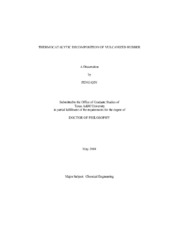| dc.description.abstract | Used vulcanized rubber tires have caused serious trouble worldwide. Current disposal and recycling methods all have undesirable side effects, and they generally do not produce maximum benefits. A thermocatalytic process using aluminum chloride as the main catalyst was demonstrated previously from 1992 to 1995 in our laboratory to convert used rubber tire to branched and ringed hydrocarbons. Products fell in the range of C4 to C8. Little to no gaseous products or fuel oil hydrocarbons of lower value were present. This project extended the previous experiments to accumulate laboratory data, and provide fundamental understanding of the thermocatalytic decomposition reaction of the model compounds including styrene-butadiene copolymers (SBR), butyl, and natural rubber. The liquid product yields of SBR and natural rubber consistently represented 20 to 30% of the original feedstock by weight. Generally, approximately 1 to 3% of the feedstock was converted to naphtha, while the remainder was liquefied petroleum gas. The liquid yields for butyl rubber were significantly higher than for SBR and natural rubber, generally ranging from 30 to 40% of the feedstock. Experiments were conducted to separate the catalyst from the residue by evaporation. Temperatures between 400 °C and 500 °C range are required to drive off significant amounts of catalyst. Decomposition of the catalyst also occurred in the recovery process. Reports in the literature and our observations strongly suggest that the AlCl3 forms an organometallic complex with the decomposing hydrocarbons so that it becomes integrated into the residue. Catalyst mixtures also were tested. Both AlCl3/NaCl and AlCl3/KCl mixtures had very small AlCl3 partial pressures at temperatures as high as 250 °C, unlike pure AlCl3 and AlCl3/MgCl2 mixtures. With the AlCl3/NaCl mixtures, decomposition of the rubber was observed at temperatures as low as 150 °C, although the reaction rates were considerably slower at lower temperatures. The amount of naphtha produced by the reaction also increased markedly, as did the yields of aromatics and cyclic paraffin. Recommendations are made for future research to definitively determine the economic and technical feasibility of the proposed thermocatalytic depolymerization process. | en |


